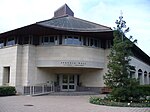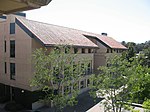Gates Computer Science Building, Stanford

The Gates Computer Science Building, or Gates building for short, is an L-shaped building that houses the Computer Science Department as well as the Computer Systems Laboratory at 353 Jane Stanford Way, Stanford University, California. Construction on the building began in 1994 and was completed in 1996 at a cost of $36 million. It was named after Microsoft founder Bill Gates, who donated $6 million for the building's construction.The building is organized into an A wing (the western ell) and a B wing (the northern ell). It is secured by an Intellikey system. Blueprints of the building are available online. The building was designed by Robert A.M. Stern Architects of New York City.
Excerpt from the Wikipedia article Gates Computer Science Building, Stanford (License: CC BY-SA 3.0, Authors, Images).Gates Computer Science Building, Stanford
Panama Mall,
Geographical coordinates (GPS) Address Nearby Places Show on map
Geographical coordinates (GPS)
| Latitude | Longitude |
|---|---|
| N 37.43 ° | E -122.17333333333 ° |
Address
Stanford University
Panama Mall 408
94305
California, United States
Open on Google Maps








